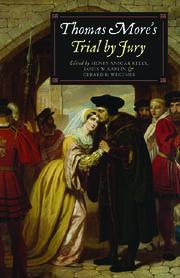Book contents
- Frontmatter
- Contents
- List of Contributors
- Preface
- Abbreviations
- Chronology
- 1 A Procedural Review of Thomas More's Trial
- 2 Natural Law and the Trial of Thomas More
- 3 A Guide to Thomas More's Trial for Modern Lawyers
- 4 Thomas More's Three Prison Letters Reporting on His Interrogations
- 5 Judicial Commentary on Thomas More's Trial
- Appendix 1 Documents
- Appendix 2 Thomas More's Trial: Docudrama
- Bibliography
- Index
Preface
Published online by Cambridge University Press: 05 February 2013
- Frontmatter
- Contents
- List of Contributors
- Preface
- Abbreviations
- Chronology
- 1 A Procedural Review of Thomas More's Trial
- 2 Natural Law and the Trial of Thomas More
- 3 A Guide to Thomas More's Trial for Modern Lawyers
- 4 Thomas More's Three Prison Letters Reporting on His Interrogations
- 5 Judicial Commentary on Thomas More's Trial
- Appendix 1 Documents
- Appendix 2 Thomas More's Trial: Docudrama
- Bibliography
- Index
Summary
Thomas More in History
Thomas More is one of the most famous persons in history. His life spanned the last part of the fifteenth century and the first part of the sixteenth century. Just as the best-known figures of the fifteenth century are undoubtedly Joan of Arc and Christopher Columbus, as was asserted by the Devil's Advocate at the opening of Joan's canonization trial in 1892, it could be argued that More ranks as one of the most familiar historical persons of the first half of the sixteenth century, along with Martin Luther and Henry VIII. Henry VIII and Thomas More joined together at first to oppose Luther and what they perceived as heresies in his writings, but they would later come to a parting of minds. They differed less on doctrine and faith than on Church law and discipline, with More considering Henry not a heretic but rather a schismatic, an advocate of caesaro-papism, “the supremacy of the civil power in the control of ecclesiastical affairs.”
But More is perhaps the most elusive of these five persons, despite the many biographies and studies about him and his accomplishments and his eventual downfall at the hands of his king, his one-time friend and enemy at the end, Henry VIII.
Until fairly recently, More was undoubtedly most familiar as the cheerful humanist whose fanciful Utopia caught the imagination of the whole world of his time and has retained its fascination to this day, along with the adjective that memorializes it, “utopian.”
- Type
- Chapter
- Information
- Thomas More's Trial by JuryA Procedural and Legal Review with a Collection of Documents, pp. xi - xviiPublisher: Boydell & BrewerPrint publication year: 2011

